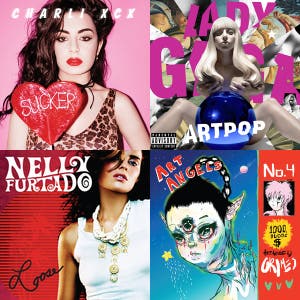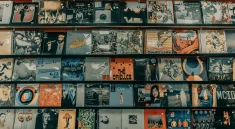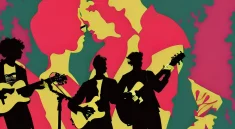Vilano – There’s something magnetic about the world of dark pop. It’s moody, atmospheric, and emotionally charged like the soundtrack to a film that hasn’t been made yet. Every bassline feels like a heartbeat, every synth like a flicker of light in the dark. But how do you capture that cinematic energy in a playlist? How do you make a sequence of songs feel like a story instead of a shuffle? Crafting a dark pop playlist that feels cinematic isn’t just about throwing together your favorite tracks it’s about creating an emotional journey that moves the listener through light, shadow, tension, and release.
Table of Contents
Why Dark Pop Feels Cinematic
The Emotional Power of Sound in Storytelling
How to Create the Perfect Opening Sequence
Designing the Rising Tension of Your Playlist
Building Atmosphere Through Transitions
Crafting the Emotional Peak of the Journey
Closing the Story with a Resonant Ending
Curating Aesthetic and Visual Identity
Tools and Platforms for Perfect Flow
How Cinematic Playlists Shape Listener Experience
Frequently Asked Questions About Dark Pop Playlist Creation
The Lasting Impact of Storytelling Through Sound
Why Dark Pop Feels Cinematic

Dark pop music has always blurred the line between music and motion picture. Its roots in synthwave and alternative pop give it a sense of visual storytelling—each track evokes a color, an image, or a scene. When artists like The Weeknd, BANKS, or TR/ST release new material, listeners often describe their music in cinematic terms: haunting, neon-lit, and emotionally layered. That’s because dark pop operates like film scoring it doesn’t just tell you what to feel, it immerses you inside that feeling.
Examples of cinematic moods in dark pop include:
-
Slow-building intros that resemble the opening credits of a film
-
Pulsating basslines that simulate tension in a thriller
-
Lush reverb vocals that echo emotional monologues
Building a dark pop playlist that feels cinematic is about translating those emotions into a listening experience that tells a complete story.
The Emotional Power of Sound in Storytelling
Music isn’t just sound it’s emotional architecture. In dark pop, producers use sound design to sculpt feelings the same way a director uses lighting to shape a scene. Synth pads act like atmosphere, basslines like movement, and vocals like dialogue. This emotional precision is why listeners gravitate toward the genre. When constructing your playlist, think of yourself as both curator and director.
Elements that define emotional storytelling include:
-
Sound textures: cold synths, distorted echoes, and slow beats
-
Tonal contrast: balancing soft melodies with deep shadows
-
Lyric progression: from despair to desire, or from chaos to clarity
The goal is to make your listener see the sound—to create imagery that evolves with each track, guiding them through an emotional narrative.
How to Create the Perfect Opening Sequence
The opening of your playlist sets the tone for everything that follows. Think of it as the establishing shot—the world your listener steps into. A great opening track doesn’t have to explode with sound; it just needs to intrigue. Choose something minimal, mysterious, or emotionally ambiguous. This draws listeners in before the full emotion unfolds.
Effective openers might include:
-
Instrumental intros that build anticipation
-
Vocals with delayed reverb for atmosphere
-
Lyrically vague tracks that hint at the journey ahead
Your playlist’s first impression decides whether the audience stays. Like a film, if the opening scene feels compelling, the rest will follow naturally.
Designing the Rising Tension of Your Playlist
Once the mood is set, your playlist needs movement—an escalation. The rising tension is the phase where energy builds but doesn’t yet resolve. This section should alternate between emotional vulnerability and rhythmic intensity, creating a sense of anticipation.
Techniques to build tension include:
-
Gradually increasing tempo or percussion density
-
Introducing heavier synth layers
-
Mixing in emotionally complex lyrics
You can even use production styles as narrative cues—move from cold, electronic minimalism to rich, cinematic layers as the playlist unfolds. That progression mirrors the way a story builds conflict before its climax.
Building Atmosphere Through Transitions
Transitions are the secret to making your playlist feel cinematic instead of like a random shuffle. In film, scenes are linked through pacing, tone, or visual rhythm. The same applies to playlists. Each song should hand off its emotional energy smoothly to the next, creating a flow that feels intentional.
Ideas for seamless transitions:
-
Match tempo and key between tracks
-
Use ambient intros or outros as bridges
-
Alternate male and female vocals to shift perspective
You can also experiment with alternating styles mixing synthwave instrumentals between vocal-driven dark pop songs creates depth and breathing room, much like a soundtrack alternates score and dialogue.
Crafting the Emotional Peak of the Journey
Every cinematic experience needs a climax the moment when tension explodes into feeling. In your dark pop playlist, this is where the most emotionally charged or sonically powerful songs should appear. It’s the turning point that defines the playlist’s identity.
Features of a strong emotional peak:
-
Driving beats or bold synth crescendos
-
Lyrics that convey vulnerability or confrontation
-
Vocals that feel raw or cinematic in scale
This section should feel both cathartic and cinematic, like the third act of a film when everything falls into place. When done right, it gives the listener a rush that lingers even after the song ends.
Closing the Story with a Resonant Ending
The ending of your playlist should feel like closure, not a fadeout. Dark pop thrives on bittersweet resolution acceptance, reflection, or quiet rebirth. Choose songs that slow the pace, simplify the soundscape, or bring emotional clarity.
Ideal closing moments often include:
-
Stripped-back instrumentals with emotional vocals
-
Melancholic melodies that leave a final impression
-
Atmospheric endings that fade like end credits
By the time the last song ends, your listener should feel like they’ve experienced something cinematic and cohesive, not just a series of tracks.
Curating Aesthetic and Visual Identity
Music in the digital era is inseparable from visuals. A dark pop playlist that feels cinematic deserves an aesthetic that mirrors its sound. The playlist title, cover art, and color scheme all help convey tone before a single note plays.
Creative ways to design your playlist identity:
-
Use cinematic imagery like neon lights or foggy silhouettes
-
Apply color grading reminiscent of noir or vaporwave aesthetics
-
Title your playlist with subtle emotional cues rather than genre labels
Think of this as your poster art it gives your playlist personality and invites people into its world.
Tools and Platforms for Perfect Flow
Curating an emotional, cinematic playlist is easier when you use the right tools. Beyond streaming services, there are platforms and software that analyze sound, tempo, and key to ensure a smooth experience.
Helpful tools for playlist creation:
-
Spotify Blend and Song Stats for analytics and flow
-
Soundiiz for multi-platform playlist management
-
AI-based generators like PlaylistAI for mood-matching
Combining technology with your creative instincts ensures that every transition, tempo shift, and emotional beat lands exactly where it should.
How Cinematic Playlists Shape Listener Experience
Playlists have evolved into modern storytelling mediums. In the dark pop scene, cinematic playlists shape emotional connections between artists and audiences. They create shared spaces where listeners can feel seen and understood. For emerging indie musicians, these playlists also serve as discovery engines—platforms that turn personal expression into cultural resonance.
Cinematic playlists redefine music consumption through:
-
Emotional engagement rather than passive listening
-
Artistic curation as a new form of storytelling
-
Algorithm-resistant discovery driven by human emotion
When you craft your playlist with intention and emotion, you’re not just curating—you’re composing an experience.
The Lasting Impact of Storytelling Through Sound
Building a dark pop playlist that feels cinematic is an act of emotional architecture. It’s not about following rules—it’s about crafting mood, pacing, and meaning through sound. When listeners press play, they should feel as though they’re entering a film one that unfolds in neon light, smoky vocals, and echoing synths. The most powerful playlists don’t just play songs; they create worlds. And in the world of dark pop, every world is a story waiting to be told.
Frequently Asked Questions About Dark Pop Playlist Creation
How do I start building a dark pop playlist?
Begin with a concept or emotional theme. Pick songs that connect sonically and emotionally, then arrange them to create a natural flow.
What makes a playlist feel cinematic?
A playlist feels cinematic when it tells a story through sound—rising tension, emotional climax, and resolution—similar to how a film unfolds.
How many songs should a cinematic playlist have?
Between 15 and 25 tracks is ideal. It’s long enough to create a story arc without losing listener attention.
Can I mix genres in a dark pop playlist?
Yes, blending genres like synthwave, alt-R&B, and dream pop can enhance depth and emotion, giving your playlist a cinematic range.
Do visuals really matter for playlists?
Absolutely. The cover art and title create context before the first note plays. They set the expectation and strengthen emotional immersion.



